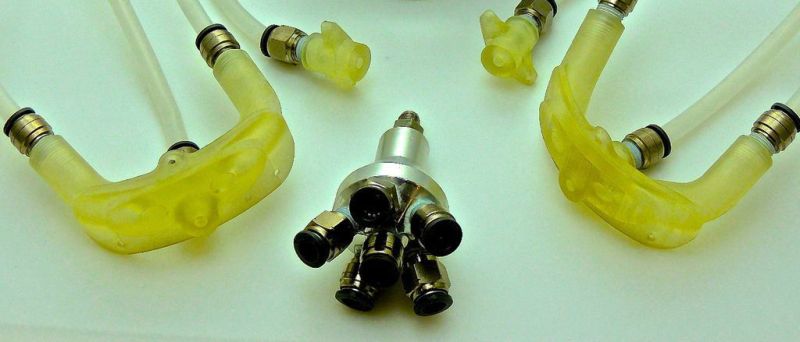Amateur rocketry has been popular for ages, with designs ranging from small toy-scale model rockets to large-scale liquid fuel designs with steerable fins. A team out of Portland State works on some large-scale amateur rockets that can fly to very high altitudes. Since the atmosphere is thin the further the rocket flies, steering fins aren’t incredibly effective once the rockets reach high altitude. A team of students tackled this problem by designing a cold-gas reaction module to steer high-altitude rockets.
The team chose nitrogen as their cold-gas propellant, which is stored in a carbon fiber tank. After passing through a regulator, the gas is routed to several gas solenoids and then to a custom 3d-printed de Laval nozzle. An Intel Edison is used to drive the system, which calculates the rocket’s orientation with a MPU-6050. Control loops use the orientation information and fire gas through any of several nozzle ports to steer the rocket.
The system does have some limits: the solenoids are either on or off, not variable, and they aren’t incredibly fast. Even with these limitations, the team is confident that their module will work great when it embarks on its maiden flight in a brand-new custom rocket next year. The team was also awesome enough to make all of their design files open-source so you can build your own (although they warn that it’s a bit complicated and dangerous). Check out the video after the break to see a test-run of the cold-gas reaction system.
Thanks for the tip, [Nathan]!















Incredible the future is open source now simply trade the nitrogen for some 30%h202/sugar mixture catalyzed through platinum screens and you have a hypergolic RCS system to rival the best.
I don’t believe that this mixture can be used as hypergolic propellant. This mixture would consist of mostly water. What is your source?
use google it works you can go hypergolic with as little as 18% h202 and sugar.
At this size and weight class I would stay away from a hypergolic liquid fuel system. Too complex to justify the effort. I doubt it’s going to give much of a weight bonus.
Are you sure that the H2O2 won’t decompose spontaenously with the sugar?
I’m fairly certain it will do exactly as you predict. At higher concentrations it will outright explode. If it didn’t I don’t see how sugar would do anything but rob the reaction of heat and clog the catalyst. If it were viable the Nazi’s would have certainly used that in the Me-163.
It’s also not hypergolic if you need a catalyst.
If the sugar stayed in solution without exploding, then the silver mesh catalyst would first break down the H2O2 into H2O and oxygen and heat, which would then combust the sugar and provide more energy for the reaction. It’s a very unstable proposition though, becuse once you get it started then the whole thing may burn up the fuel line.
A strong sugar solution with a strong H2O2 solution would work as a hypergolic mixture. You squirt them together and it lights up.
My first thought was: “Do they really need CD nozzles for an 8 barA system, surely thats not enough to get supersonic flow?”. Judging from the schlieren (nice footage btw) I was wrong. Those are some fancy shock diamonds. Only THEN did I actually read the original article. Very interesting and great job on the design and implementation.
Needs more boosters!
And more of the letter “K”.
Looks like hobbyists are playing with the big boys now, so who’s going to be the first to launch nibbles the hamster into space and return him safely to Earth?
God speed nibbles..
I think that’s what Calvin’s favorite book is about in ‘Calvin & Hobbes’, the book being: “Hamster Huey And The Gooey Kablooey”
Slow reaction jets = positive feedback, should be an interesting test flight to see if fast enough solenoids are actually fast enough.
Looks like the solenoid valves are working just fine from the video. I’m sure a bit of gain scheduling is in order for upper atmosphere, but yea nobody knows for sure until telemetry or video proof is available.
Don’t want to, but this is a federal issue. Any guided missile….. I am sure they already know.
Ask for a zone, get a waiver, turn on transponder, call departure control at center for ok, light fire. Easy peasy after the waiver.
Just an FAA form, wait 3 months to get approval. And it is not a missile. Missiles carry explosives. And it is not a guided rocket, it just has a flight stabilization system on it, it is no different than putting fins on the rocket.
They are a college sponsored engineering team. The legal liability lies with the college.
You need to have an explosive payload to run afoul from federal regulations.
Furthermore, this appears only to implement roll control, and not full guidance.
Actually, they’re cool. Guided rockets are OK as long as they’re not designed to intercept aircraft.
18 U.S. Code § 2332g – Missile systems designed to destroy aircraft
What about rollerons for stability in the denser part of the atmosphere?
Great idea! however they are not needed. The thought is to eventually use the same roll-control system as active stabilization throughout the entire flight and possibly get rid of fins all together (due to weathercocking). From the video, you can see the rcs can control roll the with no problem at normal atmosphere. The controller is designed to minimize the use of propellant, while still being able to function with up to a 50% variation in environmental changes, e.g. weight, atmosphere, and thrust force.